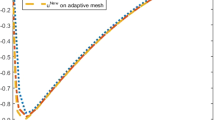Abstract
The ordered upwind method (OUM) is used to approximate the viscosity solution of the static Hamilton–Jacobi–Bellman with direction-dependent weights on unstructured meshes. The method has been previously shown to provide a solution that converges to the exact solution, but no convergence rate has been theoretically proven. In this paper, it is shown that the solutions produced by the OUM in the boundary value formulation converge at a rate of at least the square root of the largest edge length in the mesh in terms of maximum error. An example with similar order of numerical convergence is provided.






Similar content being viewed by others
References
Alton, K.: Dijkstra-Like Ordered Upwind Methods for Solving Static Hamilton–Jacobi Equations. Ph.D. thesis, University of British Columbia (2010)
Alton, K., Mitchell, I.: An ordered upwind method with precomputed stencil and monotone node acceptance for solving static convex Hamilton–Jacobi equations. J. Sci. Comput. 51, 313–348 (2012)
Angell, T.: Notes on Convex Sets. http://www.math.udel.edu/~angell/Opt/convex (2011). Accessed 5 Aug 2013
Augoula, S., Abgrall, R.: High order numerical discretization for Hamilton–Jacobi equations on triangular meshes. J. Sci. Comput. 15, 197–229 (2000)
Bardi, M., Capuzzo-Dolcetta, I.: Optimal Control and Viscosity Solutions of Hamilton–Jacobi–Bellman Equations. Birkhäuser, Basel (1997)
Bardi, M., Falcone, M.: Discrete approximation of the minimal time function for systems with regular optimal trajectories. In: Analysis and Optimation of Systems: Lecture Notes in Control and Information Sciences, vol. 144, pp. 103–112 (1990)
Borwein, J.M., Lewis, A.S.: Convex Analysis and Nonlinear Optimization: Theory and Examples. Springer, New York (2005)
Cameron, M.K.: Estimation of reactive fluxes in gradient stochastic systems using an analogy with electric circuits. J. Comput. Phys. 247, 137–152 (2013)
Crandall, M.G., Lions, P.L.: Two approximations of solutions of Hamilton–Jacobi equations. Math. Comput. 43, 1–19 (1984)
Cristiani, E.: A fast marching method for Hamilton–Jacobi equations modeling monotone front propagation. J. Sci. Comput. 39, 189–205 (2009)
Dijkstra, E.W.: A note on two problems in connexion with graphs. Numer. Math. 1, 269–271 (1959)
Engwirda, D.: MESH2D—Automatic Mesh Generation (2011)
Evans, L.: Partial Differential Equations, Graduate Studies in Mathematics, vol. 19, 2nd edn. American Mathematical Society, Providence (2010)
Falcone, M., Ferretti, R.: Discrete time high-order schemes for viscosity solutions of Hamilton–Jacobi–Bellman equations. Numer. Math. 67, 315–344 (1994)
Frew, E.: Combining area patrol, perimeter surveillance, and target tracking using ordered upwind methods. In: IEEE International Conference on Robotics and Automation, Kobe, Japan, pp. 3123–3128 (2009)
Gonzalez, R., Rofman, E.: On deterministic control problems: an approximation procedure for the optimal cost I. The stationary problem. SIAM J. Control Optim. 23, 242–266 (1985)
Hjelle, O., Petersen, A.: A Hamilton–Jacobi framework for modeling folds in structural geology. Math. Geosci. 43, 741–761 (2011)
Kimmel, R., Sethian, J.: Computing geodesic paths on manifolds. Proc. Natl. Acad. Sci. USA 95, 8431–8435 (1998)
Kumar, A., Vladimirsky, A.: An efficient method for multiobjective optimal control and optimal control subject to integral constraints. J. Comput. Math. 28, 517–551 (2010)
Monneau, R.: Introduction to the Fast Marching Method. Technical Report, Centre International de Mathématiques Pures et Appliqués (2010)
Sethian, J., Vladimirsky, A.: Ordered upwind methods for static Hamilton–Jacobi equations: theory and algorithms. SIAM J. Numer. Anal. 41, 325–363 (2003)
Shum, A., Morris, K.A., Khajepour, A.: Direction-dependent optimal path planning for autonomous vehicles. Robot. Auton. Syst. 70, 202–214 (2015)
Souganidis, P.: Approximation scheme for viscosity solutions of Hamilton–Jacobi equations. J. Differ. Equ. 59, 1–43 (1985)
Valero-Gómez, A., Gómez, J.V., Garrido, S., Moreno, L.: The path to efficiency: fast marching method for safer, more efficient mobile robot trajectories. IEEE Robot. Autom. Mag. 20(4), 111–120 (2013)
Vladimirsky, A.: Fast Methods for Static Hamilton–Jacobi Partial Differential Equations. Ph.D. thesis, University of Califoria, Berkeley (2001)
Author information
Authors and Affiliations
Corresponding author
Additional information
This work has been supported by the Ontario Government, and Natural Sciences and Engineering Research Council.
Rights and permissions
About this article
Cite this article
Shum, A., Morris, K. & Khajepour, A. Convergence Rate for the Ordered Upwind Method. J Sci Comput 68, 889–913 (2016). https://doi.org/10.1007/s10915-016-0163-3
Received:
Revised:
Accepted:
Published:
Issue Date:
DOI: https://doi.org/10.1007/s10915-016-0163-3




